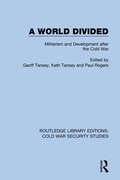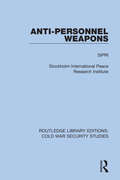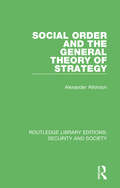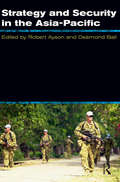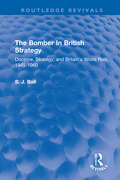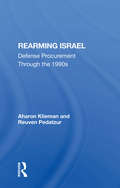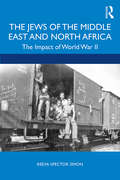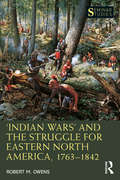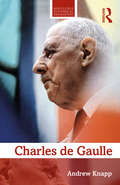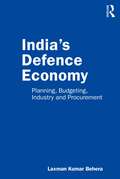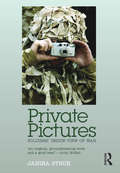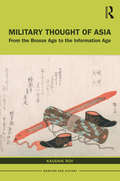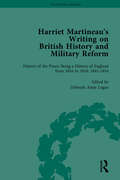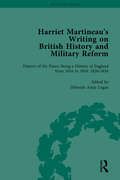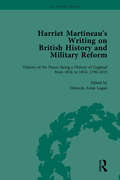- Table View
- List View
A World Divided: Militarism and Development after the Cold War (Routledge Library Editions: Cold War Security Studies #1)
by Geoff Tansey Kath Tansey Paul RogersThis book, first published in 1994, analyses the changing world order at the end of the Cold War. As the East-West military axis was replaced by North-South economic polarization and global insecurity, it became clear that future wars were likely to stem from resource and environmental conflict and from the effects of mass movements of displaced people. Using case studies from around the world, the authors diagnose the problems caused by increasing militarism, and analyse the links between conflict, poverty, development and the environment.
Anti-personnel Weapons (Routledge Library Editions: Cold War Security Studies #3)
by SipriThis book, first published in 1978, analyses the development, uses and effects of conventional anti-personnel weapons such as rifles and machine guns, grenades, bombs, shells and mines. It provides the historical, military, technical and clinical background to the international legal discussions as part of the ongoing efforts to prohibit or restrict the uses of some of the more inhumane and indiscriminate of these weapons, the most successful being the 1997 Ottawa Treaty that banned the use of anti-personnel mines.
A World Divided: Militarism and Development after the Cold War (Routledge Library Editions: Cold War Security Studies #1)
by Geoff Tansey Kath Tansey Paul RogersThis book, first published in 1994, analyses the changing world order at the end of the Cold War. As the East-West military axis was replaced by North-South economic polarization and global insecurity, it became clear that future wars were likely to stem from resource and environmental conflict and from the effects of mass movements of displaced people. Using case studies from around the world, the authors diagnose the problems caused by increasing militarism, and analyse the links between conflict, poverty, development and the environment.
Anti-personnel Weapons (Routledge Library Editions: Cold War Security Studies #3)
by SipriThis book, first published in 1978, analyses the development, uses and effects of conventional anti-personnel weapons such as rifles and machine guns, grenades, bombs, shells and mines. It provides the historical, military, technical and clinical background to the international legal discussions as part of the ongoing efforts to prohibit or restrict the uses of some of the more inhumane and indiscriminate of these weapons, the most successful being the 1997 Ottawa Treaty that banned the use of anti-personnel mines.
Social Order and the General Theory of Strategy (Routledge Library Editions: Security and Society)
by Alexander AtkinsonIs there a place left in international politics for the real use of violence as an instrument of policy in the nuclear age? Originally published in 1981, Dr Atkinson attempts to answer this question with new considerations in the presentation of a general theory of strategy. He argues that the classical theory of strategy, so influential for the 19th century and for the better half of the 20th century, was built on a mainly hidden structure of reasoning that still infests theory today. The larger and socially-rooted lessons that insurgent warfare can inform, as best exemplified in the primary sources of the Chinese Civil War period, reveal in a new light this hidden structure of which Clausewitz is the earliest and most eloquent example. By this analysis of the insurgent and classical paradigm opposites the author intends to strip away the blinds of convention still circulating in theory today so that observers and students of international politics may see where new forms of politically motivated violence in the nuclear age seem more than ever to be headed. Here we have perfect paradigm opposites. In the conventional world battle-field action and ideally 'decisive battle' is the center of all other issues in which such conventional logic in the end sweeps up everything else and runs it back through the logic into success or failure of armed power on the battle-field. Everything hangs on this. In the 'revisionist' insurgent world where social order is weaponized as an object and source of military power through its inherent and valuable (armed) power structures social order replaces narrow battle-field action (ideally focused on 'decisive battle') and alternatively redirects the entire logic and all other considerations, including previously heroic conventional military assets, are remodeled to act against (armed) enemy power structures inherent (as always) in social order for the ultimate object of military victory. Again, everything is on this alone. Which paradigm - one the opposite mirror image of the other - will prevail will depend on the stability and power of the nation state and its institutions, the continued and unhappy collapse on which I base the General Theory.
Social Order and the General Theory of Strategy (Routledge Library Editions: Security and Society)
by Alexander AtkinsonIs there a place left in international politics for the real use of violence as an instrument of policy in the nuclear age? Originally published in 1981, Dr Atkinson attempts to answer this question with new considerations in the presentation of a general theory of strategy. He argues that the classical theory of strategy, so influential for the 19th century and for the better half of the 20th century, was built on a mainly hidden structure of reasoning that still infests theory today. The larger and socially-rooted lessons that insurgent warfare can inform, as best exemplified in the primary sources of the Chinese Civil War period, reveal in a new light this hidden structure of which Clausewitz is the earliest and most eloquent example. By this analysis of the insurgent and classical paradigm opposites the author intends to strip away the blinds of convention still circulating in theory today so that observers and students of international politics may see where new forms of politically motivated violence in the nuclear age seem more than ever to be headed. Here we have perfect paradigm opposites. In the conventional world battle-field action and ideally 'decisive battle' is the center of all other issues in which such conventional logic in the end sweeps up everything else and runs it back through the logic into success or failure of armed power on the battle-field. Everything hangs on this. In the 'revisionist' insurgent world where social order is weaponized as an object and source of military power through its inherent and valuable (armed) power structures social order replaces narrow battle-field action (ideally focused on 'decisive battle') and alternatively redirects the entire logic and all other considerations, including previously heroic conventional military assets, are remodeled to act against (armed) enemy power structures inherent (as always) in social order for the ultimate object of military victory. Again, everything is on this alone. Which paradigm - one the opposite mirror image of the other - will prevail will depend on the stability and power of the nation state and its institutions, the continued and unhappy collapse on which I base the General Theory.
Strategy and Security in the Asia-Pacific: Global and regional dynamics
by Desmond Ball Robert AysonFrom the war on terror to the rise of China, this book unlocks the major strategic themes and security challenges of the early twenty-first century. Strategy and Security in the Asia-Pacific provides the analytical frameworks needed to make sense of this complex but exciting strategic universe. Offering a unique mix of global strategic thinking and Asia-Pacific security analysis, this book is for readers from Sydney to Seoul who want to put their own local security challenges in a wider regional and global context. It is also for North American and European readers requiring an understanding of the dynamic security developments in the Asia-Pacific region around which so much of global strategy is increasingly based. The really vital questions facing the international community are dealt with here: Why do governments and groups still use armed force? Has warfare really changed in the information age? Why should we be concerned about non-traditional security challenges such as water shortages and the spread of infectious disease? Is a great clash imminent between the United States and China? What are the prospects for peace on the Korean peninsula and between India and Pakistan? Can Southeast Asia survive the challenges of transnational terrorism? What does security mean for the Pacific island countries and for Australia and New Zealand? With contributions from leading commentators and analysts, Strategy and Security in the Asia-Pacific offers a comprehensive and authoritative introduction to the field.
Strategy and Security in the Asia-Pacific: Global and regional dynamics (Canberra Papers On Strategy And Defence #No. 139)
by Robert Ayson Desmond BallFrom the war on terror to the rise of China, this book unlocks the major strategic themes and security challenges of the early twenty-first century. Strategy and Security in the Asia-Pacific provides the analytical frameworks needed to make sense of this complex but exciting strategic universe. Offering a unique mix of global strategic thinking and Asia-Pacific security analysis, this book is for readers from Sydney to Seoul who want to put their own local security challenges in a wider regional and global context. It is also for North American and European readers requiring an understanding of the dynamic security developments in the Asia-Pacific region around which so much of global strategy is increasingly based. The really vital questions facing the international community are dealt with here: Why do governments and groups still use armed force? Has warfare really changed in the information age? Why should we be concerned about non-traditional security challenges such as water shortages and the spread of infectious disease? Is a great clash imminent between the United States and China? What are the prospects for peace on the Korean peninsula and between India and Pakistan? Can Southeast Asia survive the challenges of transnational terrorism? What does security mean for the Pacific island countries and for Australia and New Zealand? With contributions from leading commentators and analysts, Strategy and Security in the Asia-Pacific offers a comprehensive and authoritative introduction to the field.
The Bomber In British Strategy: Doctrine, Strategy, and Britain's World Role, 1945-1960 (Routledge Revivals)
by S. J. BallBetween 1945 and 1960, Great Britain constructed a substantial nuclear-armed bomber force. The creation of this force had ramifications that extended well beyond the confines of military policy. The process played a large part in defining relations with the United States, and the belief that these bombers could replace conventional forces convinced successive British governments that Great Britain could maintain a significant global military role. Originally published in 1995 and drawing on both archives and oral testimony, this book analyses British strategic discourse and its influence on British foreign policy in the early decades of the Cold War.
Rearming Israel: Defense Procurement Through The 1990s
by Aharon Klieman Reuven PedatzurThis study analyzes the key functions of arms planning and procurement in the ongoing Israeli defence effort. Part I addresses individual constraints placed on the shaping of arms control policy. Part II asks how Israel might best meet its arms needs over the next decade.
The Jews of the Middle East and North Africa: The Impact of World War II
by Reeva Spector SimonIncorporating published and archival material, this volume fills an important gap in the history of the Jewish experience during World War II, describing how the war affected Jews living along the southern rim of the Mediterranean and the Levant, from Morocco to Iran. Surviving the Nazi slaughter did not mean that Jews living in the Middle East and North Africa were unaffected by the war: there was constant anti-Semitic propaganda and general economic deprivation; communities were bombed; and Jews suffered because of the anti-Semitic Vichy regulations that left them unemployed, homeless, and subject to forced labor and deportation to labor camps. Nevertheless, they fought for the Allies and assisted the Americans and the British in the invasion of North Africa. These men and women were community leaders and average people who, despite their dire economic circumstances, worked with the refugees attempting to escape the Nazis via North Africa, Turkey, or Iran and connected with international aid agencies during and after the war. By 1945, no Jewish community had been left untouched, and many were financially decimated, a situation that would have serious repercussions on the future of Jews in the region. Covering the entire Middle East and North Africa region, this book on World War II is a key resource for students, scholars, and general readers interested in Jewish history, World War II, and Middle East history.
‘Indian Wars’ and the Struggle for Eastern North America, 1763–1842 (Seminar Studies)
by Robert M. Owens‘Indian Wars’ and the Struggle for Eastern North America, 1763–1842 examines the contest between Native Americans and Anglo-Americans for control of the lands east of the Mississippi River, through the lens of native attempts to form pan-Indian unions, and Anglo-Americans’ attempts to thwart them. The story begins in the wake of the Seven Years’ War and ends with the period of Indian Removal and the conclusion of the Second Seminole War in 1842. Anglo-Americans had feared multi-tribal coalitions since the 1670s and would continue to do so into the early nineteenth century, long after there was a credible threat, due to the fear of slave rebels joining the Indians. By focusing on the military and diplomatic history of the topic, the work allows for a broad understanding of American Indians and frontier history, serving as a gateway to the study of Native American history. This concise and accessible text will appeal to a broad intersection of students in ethnic studies, history, and anthropology.
‘Indian Wars’ and the Struggle for Eastern North America, 1763–1842 (Seminar Studies)
by Robert M. Owens‘Indian Wars’ and the Struggle for Eastern North America, 1763–1842 examines the contest between Native Americans and Anglo-Americans for control of the lands east of the Mississippi River, through the lens of native attempts to form pan-Indian unions, and Anglo-Americans’ attempts to thwart them. The story begins in the wake of the Seven Years’ War and ends with the period of Indian Removal and the conclusion of the Second Seminole War in 1842. Anglo-Americans had feared multi-tribal coalitions since the 1670s and would continue to do so into the early nineteenth century, long after there was a credible threat, due to the fear of slave rebels joining the Indians. By focusing on the military and diplomatic history of the topic, the work allows for a broad understanding of American Indians and frontier history, serving as a gateway to the study of Native American history. This concise and accessible text will appeal to a broad intersection of students in ethnic studies, history, and anthropology.
Charles de Gaulle (Routledge Historical Biographies)
by Andrew KnappIn this new biography, Andrew Knapp concisely dissects each of the major controversies surrounding General Charles de Gaulle, leader of the Free French during the Second World War and President of France from 1959 to 1969. From the beginning of de Gaulle’s military career in 1909 to an analysis of legacies and myths after his death in 1970, this study examines the path by which the French came to honour him as the greatest Frenchman of all time, and as the twentieth century’s pre-eminent world statesman. In each chapter, Knapp analyses de Gaulle’s participation in key events such as the development of France’s resistance against Nazi Germany, the decolonisation of Algeria, the birth of the French Fifth Republic, and the gigantic upheaval of May 1968. Simultaneously, this study questions de Gaulle’s actions and motives throughout his life. By exploring the justification of the contemporary ‘de Gaulle myth’, Knapp concludes by shedding new light on the influence of de Gaulle in the political culture of twenty-first-century France. Through careful analysis of primary sources as well as recent scholarship, this biography is an invaluable source for scholars and students of modern history, the history of France, political institutions, and international relations.
Charles de Gaulle (Routledge Historical Biographies)
by Andrew KnappIn this new biography, Andrew Knapp concisely dissects each of the major controversies surrounding General Charles de Gaulle, leader of the Free French during the Second World War and President of France from 1959 to 1969. From the beginning of de Gaulle’s military career in 1909 to an analysis of legacies and myths after his death in 1970, this study examines the path by which the French came to honour him as the greatest Frenchman of all time, and as the twentieth century’s pre-eminent world statesman. In each chapter, Knapp analyses de Gaulle’s participation in key events such as the development of France’s resistance against Nazi Germany, the decolonisation of Algeria, the birth of the French Fifth Republic, and the gigantic upheaval of May 1968. Simultaneously, this study questions de Gaulle’s actions and motives throughout his life. By exploring the justification of the contemporary ‘de Gaulle myth’, Knapp concludes by shedding new light on the influence of de Gaulle in the political culture of twenty-first-century France. Through careful analysis of primary sources as well as recent scholarship, this biography is an invaluable source for scholars and students of modern history, the history of France, political institutions, and international relations.
India’s Defence Economy: Planning, Budgeting, Industry and Procurement
by Laxman Kumar BeheraAs the fourth largest military spender in the world, India has a huge defence economy supported by a budget amounting to nearly $67 billion in 2020–21. This book examines how well India’s defence economy is managed, through a detailed statistical exposition of five key themes – defence planning, expenditure, arms production, procurement and offsets. This book is based on hard-core evidence collected from multiple government and other credible sources including the ministries of Defence, Finance, and Commerce and Industry, Comptroller and Auditor General of India and the Reserve Bank of India. It discusses key issues such as the evolution of India’s defence plan; the feasibility of increasing defence spending; India’s defence acquisition system; and the recent reform measures taken under the rubric of the ‘Make in India’ initiative. Well supplemented with original tables and figures, India’s Defence Economy will be indispensable to students and researchers of defence and security studies, politics and international relations, finance, development studies, economics, strategic studies, South Asian politics, foreign policy and peace studies. It will also be of interest to defence ministry officials, senior armed forces personnel, military attachés, defence training institutes and strategic think tanks.
India’s Defence Economy: Planning, Budgeting, Industry and Procurement
by Laxman Kumar BeheraAs the fourth largest military spender in the world, India has a huge defence economy supported by a budget amounting to nearly $67 billion in 2020–21. This book examines how well India’s defence economy is managed, through a detailed statistical exposition of five key themes – defence planning, expenditure, arms production, procurement and offsets. This book is based on hard-core evidence collected from multiple government and other credible sources including the ministries of Defence, Finance, and Commerce and Industry, Comptroller and Auditor General of India and the Reserve Bank of India. It discusses key issues such as the evolution of India’s defence plan; the feasibility of increasing defence spending; India’s defence acquisition system; and the recent reform measures taken under the rubric of the ‘Make in India’ initiative. Well supplemented with original tables and figures, India’s Defence Economy will be indispensable to students and researchers of defence and security studies, politics and international relations, finance, development studies, economics, strategic studies, South Asian politics, foreign policy and peace studies. It will also be of interest to defence ministry officials, senior armed forces personnel, military attachés, defence training institutes and strategic think tanks.
Private Pictures: Soldiers' Inside View of War
by Janina StrukSnapshots taken by American soldiers of Iraqi prisoners stripped naked, humiliated and tortured shocked the world in 2004 and more have followed from the conflict in Afghanistan, but whether the public have been horrified by the soldiers' conduct or the fact they have taken pictures has not been clear. In fact, as this remarkable book reveals and relates, soldiers have taken photographs of war and its atrocities for more than 100 years. But their pictures are private, intended mainly for the soldiers themselves, as mementoes or as attempts to make sense of the chaos, brutality and boredom of war. They can be gruesome or sociable, shocking or mundane and they are seldom regarded as serious contributions to a visual culture of war, which since 1939 has been dominated by professional war photography. But with the 21st-century shift to simple digital photography, transmission by the internet available to all, and a new 'citizen journalism', soldiers' pictures are acquiring a new resonance."Private Pictures" traces this unacknowledged genre of photography from the origins of popular photography in the Boer War through to the present day; it discusses how the images have been used and it asks: what effect might the wider appreciation of soldiers' pictures have on the popular perception of war?
Private Pictures: Soldiers' Inside View of War
by Janina StrukSnapshots taken by American soldiers of Iraqi prisoners stripped naked, humiliated and tortured shocked the world in 2004 and more have followed from the conflict in Afghanistan, but whether the public have been horrified by the soldiers' conduct or the fact they have taken pictures has not been clear. In fact, as this remarkable book reveals and relates, soldiers have taken photographs of war and its atrocities for more than 100 years. But their pictures are private, intended mainly for the soldiers themselves, as mementoes or as attempts to make sense of the chaos, brutality and boredom of war. They can be gruesome or sociable, shocking or mundane and they are seldom regarded as serious contributions to a visual culture of war, which since 1939 has been dominated by professional war photography. But with the 21st-century shift to simple digital photography, transmission by the internet available to all, and a new 'citizen journalism', soldiers' pictures are acquiring a new resonance."Private Pictures" traces this unacknowledged genre of photography from the origins of popular photography in the Boer War through to the present day; it discusses how the images have been used and it asks: what effect might the wider appreciation of soldiers' pictures have on the popular perception of war?
Military Thought of Asia: From the Bronze Age to the Information Age (Warfare and History)
by Kaushik RoyMilitary Thought of Asia challenges the assertion that the generation of rational secular ideas about the conduct of warfare is the preserve of the West, by analysing the history of ideas of warfare in Asia from the ancient period to the present. The volume takes a transcontinental and comparative approach to provide a broad overview of the evolution of military thought in Asia. The military traditions and theories which have emerged in different parts of Eurasia throughout history are products of geopolitics and unique to the different regions. The book considers the systematic and tight representation of ideas by famous figures including Kautlya and Sun Tzu. At the same time, it also highlights publications on military affairs by small men like mid-ranking officers and scattered ideas regarding the origin, nature and societal impact of organised violence present in miscellaneous sources like coins, inscriptions, paintings and fictional literature. In so doing, the book fills a historiographical gap in scholarship on military thought, which marginalises Asia to the part of cameo, and historicises the evolution of theory and the praxis of warfare. The volume shows that the ‘East’ has a long unbroken tradition of conceptualising war and its place in society from the Classical Era to the Information Age. It is essential reading for those interested in the evolution of military thought throughout history, particularly in Asia.
Military Thought of Asia: From the Bronze Age to the Information Age (Warfare and History)
by Kaushik RoyMilitary Thought of Asia challenges the assertion that the generation of rational secular ideas about the conduct of warfare is the preserve of the West, by analysing the history of ideas of warfare in Asia from the ancient period to the present. The volume takes a transcontinental and comparative approach to provide a broad overview of the evolution of military thought in Asia. The military traditions and theories which have emerged in different parts of Eurasia throughout history are products of geopolitics and unique to the different regions. The book considers the systematic and tight representation of ideas by famous figures including Kautlya and Sun Tzu. At the same time, it also highlights publications on military affairs by small men like mid-ranking officers and scattered ideas regarding the origin, nature and societal impact of organised violence present in miscellaneous sources like coins, inscriptions, paintings and fictional literature. In so doing, the book fills a historiographical gap in scholarship on military thought, which marginalises Asia to the part of cameo, and historicises the evolution of theory and the praxis of warfare. The volume shows that the ‘East’ has a long unbroken tradition of conceptualising war and its place in society from the Classical Era to the Information Age. It is essential reading for those interested in the evolution of military thought throughout history, particularly in Asia.
The Jews of the Middle East and North Africa: The Impact of World War II
by Reeva Spector SimonIncorporating published and archival material, this volume fills an important gap in the history of the Jewish experience during World War II, describing how the war affected Jews living along the southern rim of the Mediterranean and the Levant, from Morocco to Iran. Surviving the Nazi slaughter did not mean that Jews living in the Middle East and North Africa were unaffected by the war: there was constant anti-Semitic propaganda and general economic deprivation; communities were bombed; and Jews suffered because of the anti-Semitic Vichy regulations that left them unemployed, homeless, and subject to forced labor and deportation to labor camps. Nevertheless, they fought for the Allies and assisted the Americans and the British in the invasion of North Africa. These men and women were community leaders and average people who, despite their dire economic circumstances, worked with the refugees attempting to escape the Nazis via North Africa, Turkey, or Iran and connected with international aid agencies during and after the war. By 1945, no Jewish community had been left untouched, and many were financially decimated, a situation that would have serious repercussions on the future of Jews in the region. Covering the entire Middle East and North Africa region, this book on World War II is a key resource for students, scholars, and general readers interested in Jewish history, World War II, and Middle East history.
Harriet Martineau's Writing on British History and Military Reform, vol 5
by Deborah Logan Kathryn SklarThis volume contains Harriet Martineau's writings on the history of England and its efforts and negotiations to promote peace between 1841 and 1854, providing a detailed account of the political revolutions and democratic and military reforms that shaped England's history.
Harriet Martineau's Writing on British History and Military Reform, vol 3
by Deborah Logan Kathryn SklarThis volume contains Harriet Martineau's writings on the history of England and its efforts and negotiations to promote peace between 1826 and 1834, providing a detailed account of the political revolutions and democratic and military reforms that shaped England's history.
Harriet Martineau's Writing on British History and Military Reform, vol 1
by Deborah Logan Kathryn SklarThis volume contains Harriet Martineau's writings on the history of England and its efforts and negotiations to promote peace between 1790 and 1815, providing a detailed account of the political revolutions and democratic and military reforms that shaped England's history.
